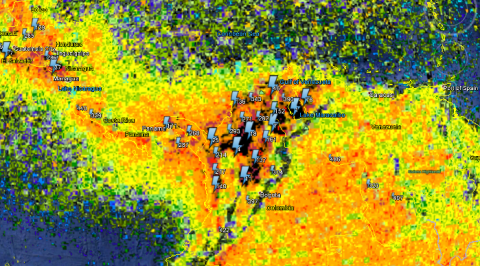
The GHRC DAAC has published the “LIS 0.1 Degree Very High Resolution Gridded Lightning Climatology Data Collection” (DOI: http://dx.doi.org/10.5067/LIS/LIS/DATA304), comprising five datasets:
LIS 0.1 Degree Very High Resolution Gridded Lightning Full Climatology (VHRFC)
LIS 0.1 Degree Very High Resolution Gridded Lightning Monthly Climatology (VHRMC)
LIS 0.1 Degree Very High Resolution Gridded Lightning Diurnal Climatology (VHRDC)
LIS 0.1 Degree Very High Resolution Gridded Lightning Annual Climatology (VHRAC)
LIS 0.1 Degree Very High Resolution Gridded Lightning Seasonal Climatology (VHRSC)
These datasets, developed by Dr. Rachel Albrecht of the University of Sao Paulo, provide gridded climatologies of total lightning flash rates seen by the Lightning Imaging Sensor (LIS), and are an evolution of the LIS/OTD low resolution and high resolution lightning climatologies already at the GHRC DAAC (collection DOI: http:/dx.doi.org/10.5067/LIS/LIS-OTD/DATA311). Their very high spatial resolution (0.1°) allows more precise identification of lightning hotspots. Dr. Albrecht’s analysis of these data revealing that the Earth's principal lightning hotspot occurs over Lake Maracaibo in Venezuela has been featured in news items by the American Meteorological Society and LiveScience. Interactive visualizations of these datasets and the top 500 lightning hotspots are available at https://ghrc.nsstc.nasa.gov/lightning/data/data_lis_vhr-climatology.html.


 GHRC DAAC published the
GHRC DAAC published the  Manil Maskey presented GHRC’s new "Field Campaign Information Explorer" tool as part of the ESDIS webinar series. This tool is particularly suited for exploring and visualizing data associated with events, field campaigns and airborne missions. It initially targeted the Hurricane and Severe Storm Sentinel (HS3) Earth Venture 1 mission, and will be generalized for the GHRC’s field campaign data collection. The webinar was well received by the audience and many additional features were suggested by potential users.
Manil Maskey presented GHRC’s new "Field Campaign Information Explorer" tool as part of the ESDIS webinar series. This tool is particularly suited for exploring and visualizing data associated with events, field campaigns and airborne missions. It initially targeted the Hurricane and Severe Storm Sentinel (HS3) Earth Venture 1 mission, and will be generalized for the GHRC’s field campaign data collection. The webinar was well received by the audience and many additional features were suggested by potential users. Helen Conover and Sherry Harrison attended the EOS and SNPP SIPS Workshop February 22-23, 2015 at NASA GSFC. Conover and Harrison represented the AMSR SIPS at the GHRC DAAC, presenting the status of the AMSR SIPS activities to NASA Management. These activities include AMSR-E, AMSR2, and LANCE near real-time AMSR2 data processing.
Helen Conover and Sherry Harrison attended the EOS and SNPP SIPS Workshop February 22-23, 2015 at NASA GSFC. Conover and Harrison represented the AMSR SIPS at the GHRC DAAC, presenting the status of the AMSR SIPS activities to NASA Management. These activities include AMSR-E, AMSR2, and LANCE near real-time AMSR2 data processing.



